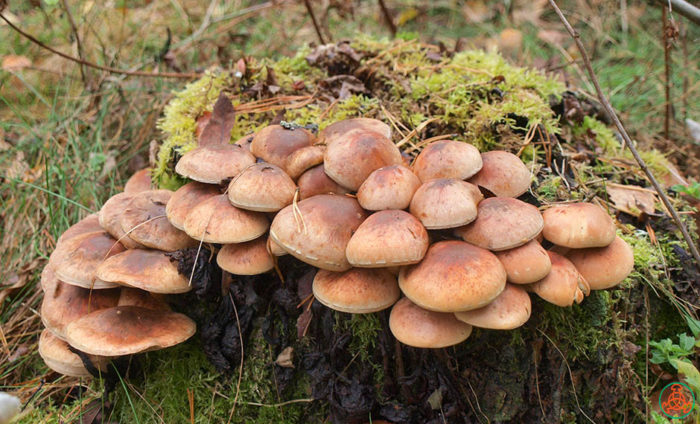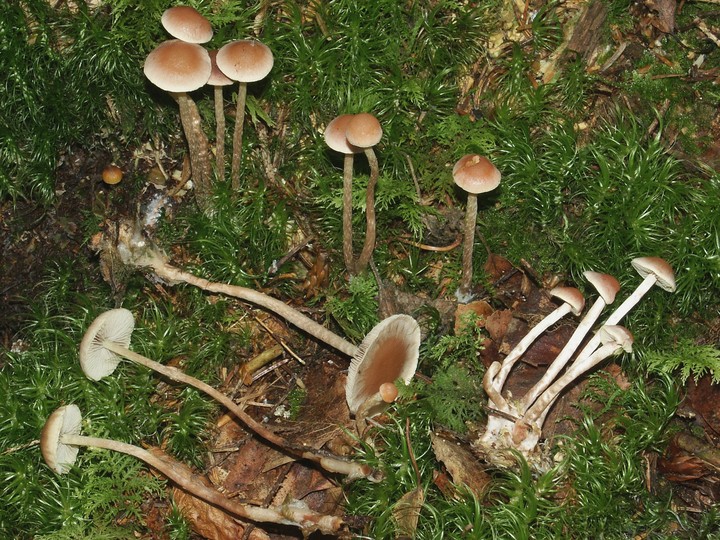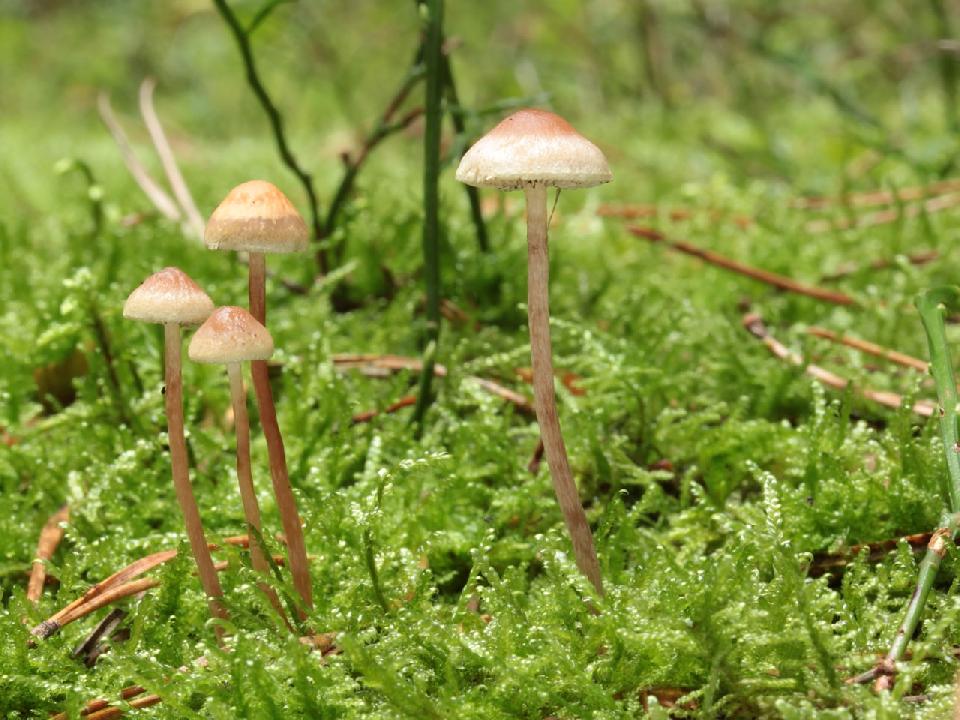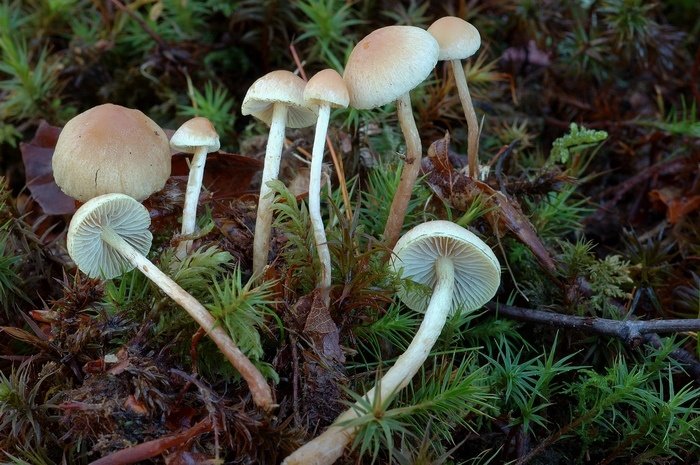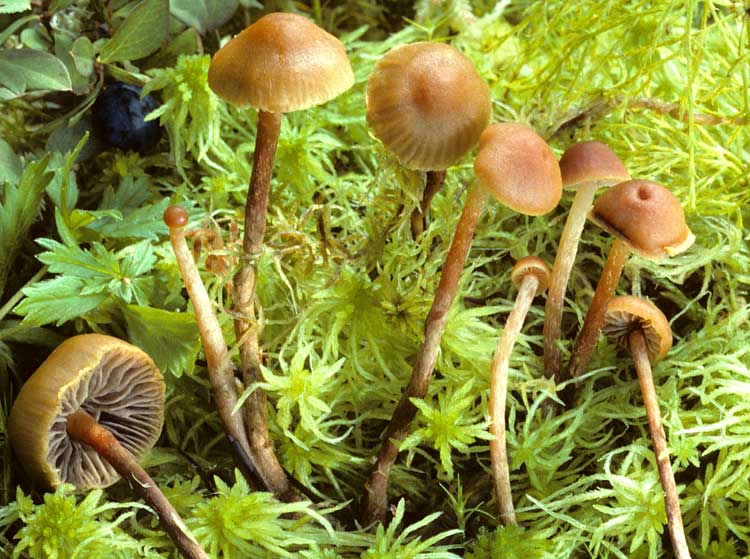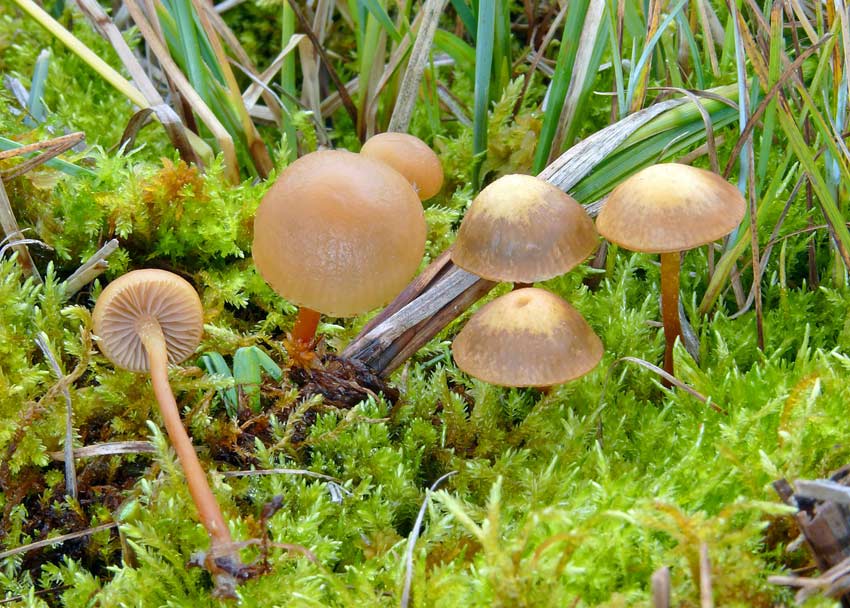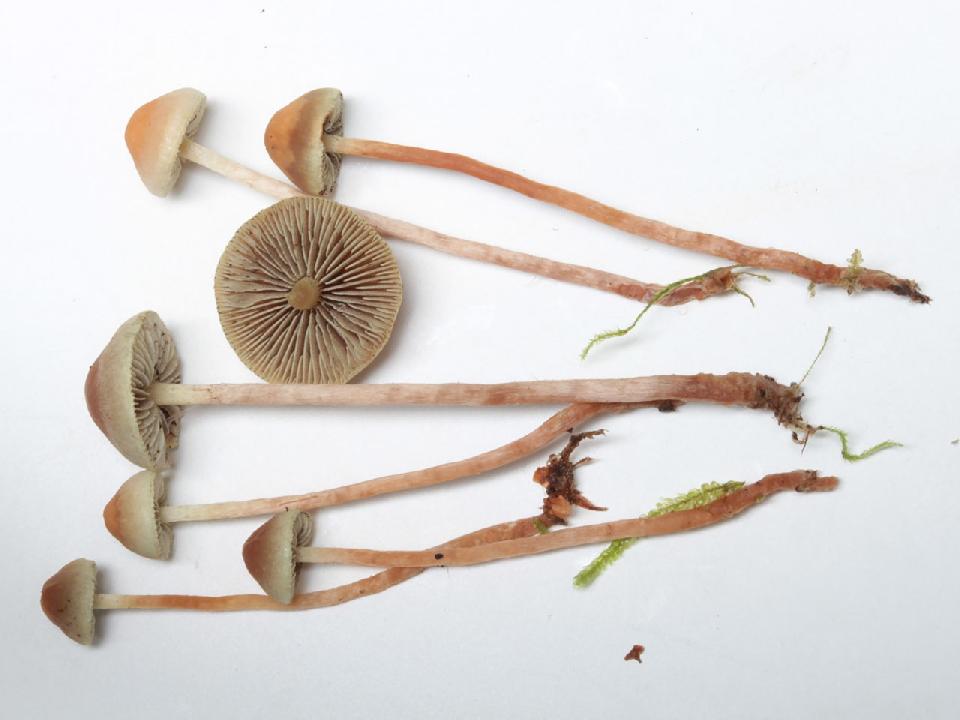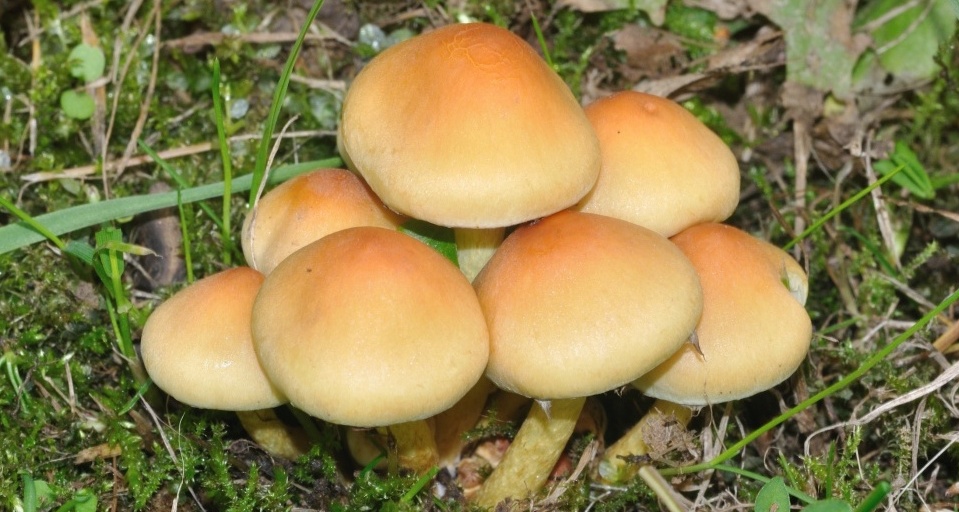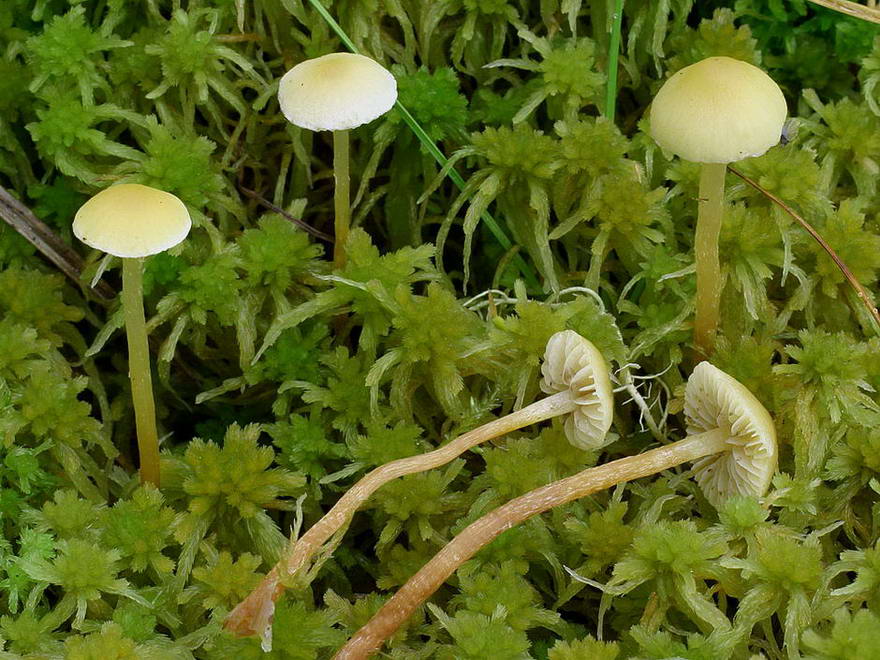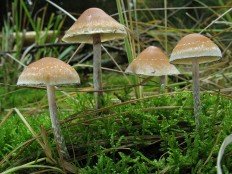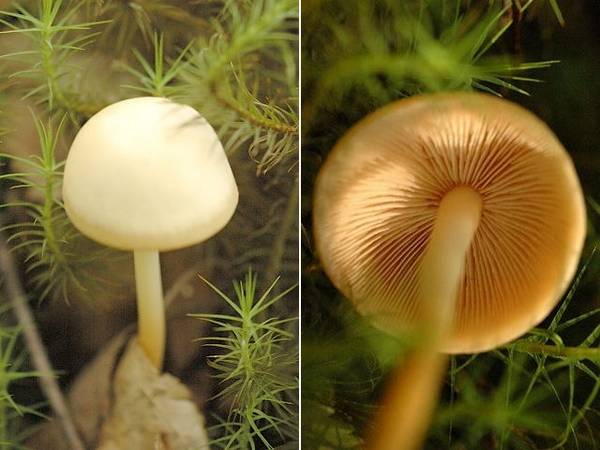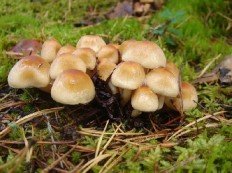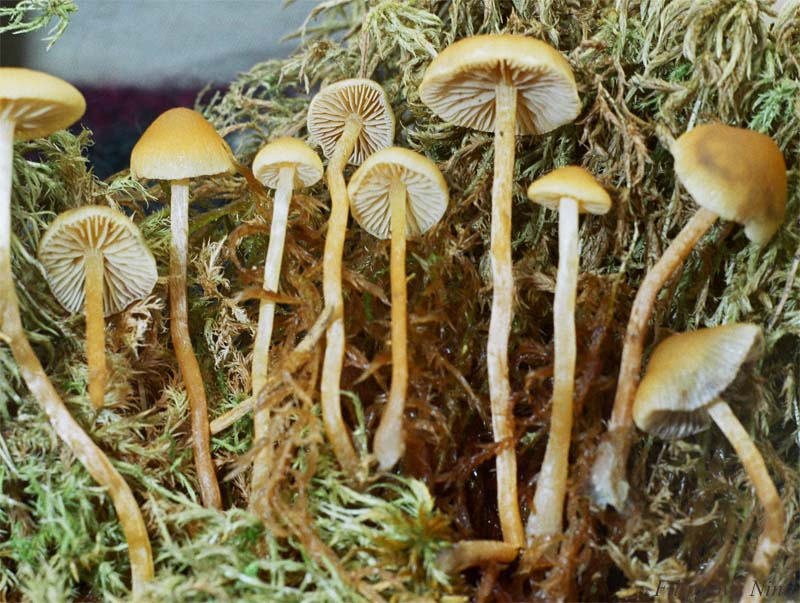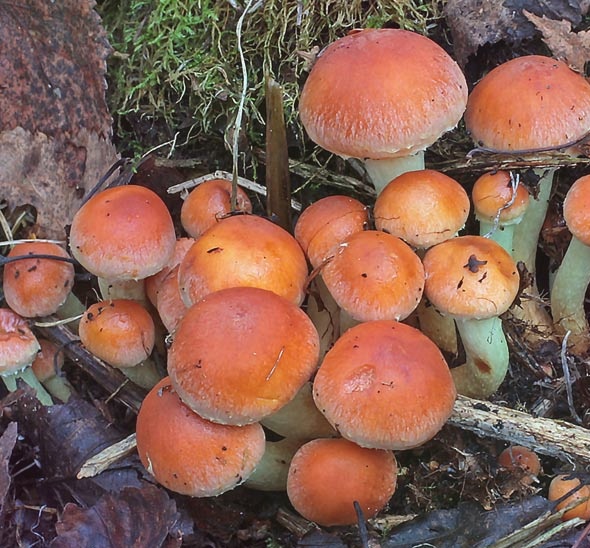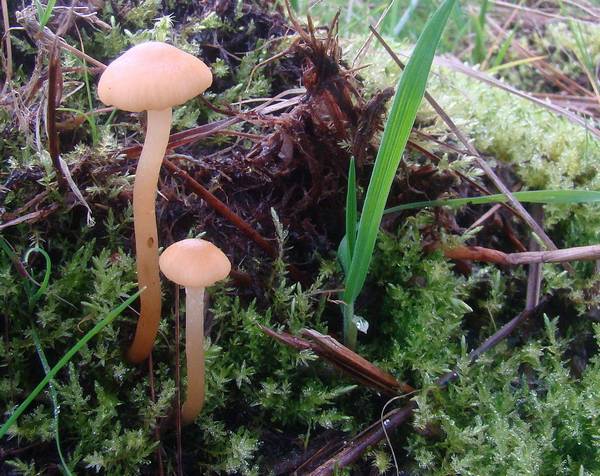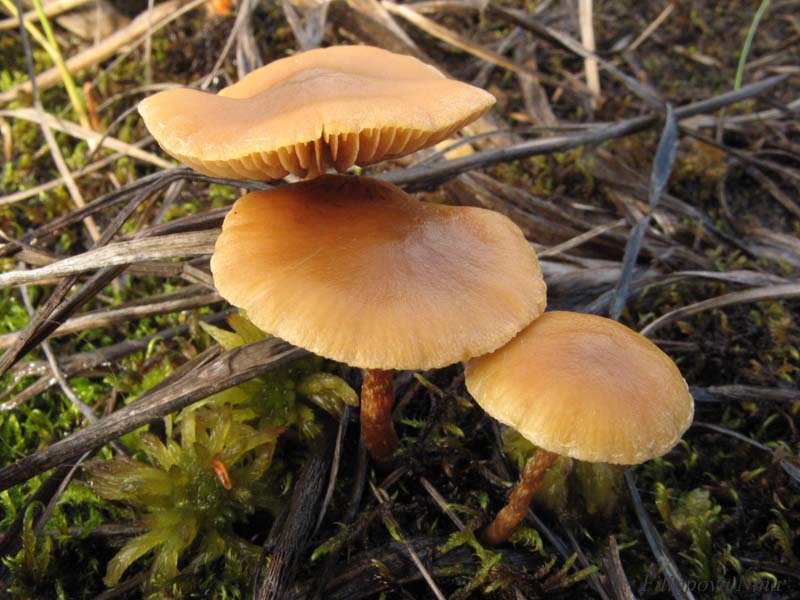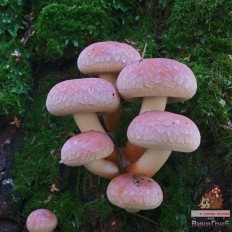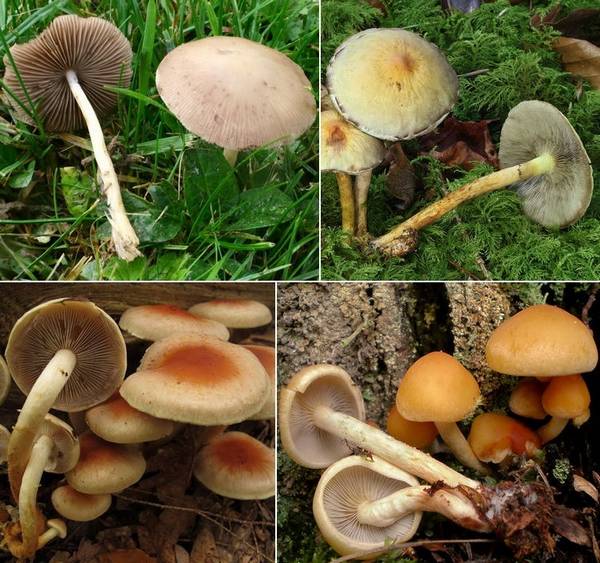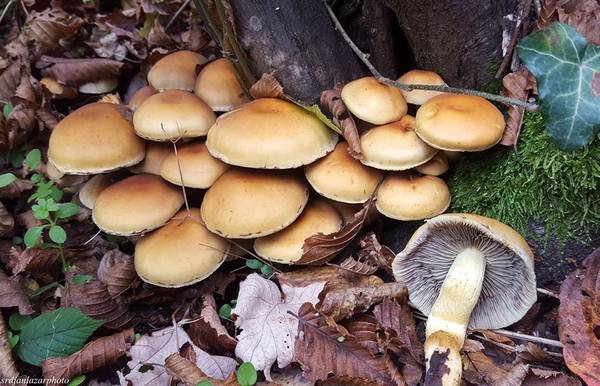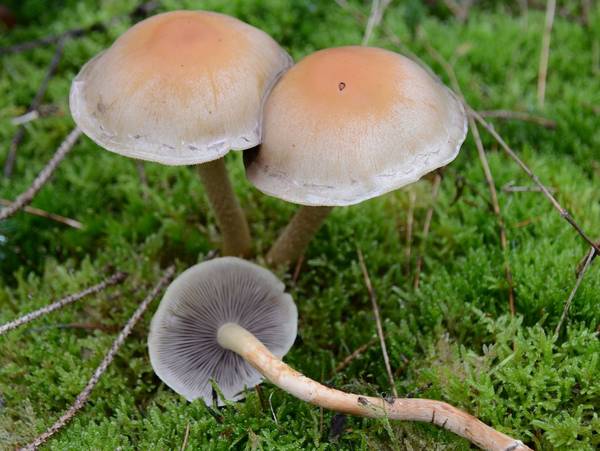Dangerous false doubles
The brick-red honey mushroom has quite a lot of twins: both edible and poisonous. You can see them in more detail in the photo or see the table:
| Species name | Differences | Places and times of growth | Edibility |
| Summer mushroom | It has a pale grayish color of the cap and a brownish tint in the middle. He completely lacks a special rim in the form of a fringe on the leg. Characterized by a pronounced bitter taste of the pulp and a rather unpleasant odor. | Deciduous and mixed forests of a temperate climate. It grows in April - November. | Edible |
| False foam seroplate | Whitish-yellowish, and then bluish-gray plates, yellow-orange, with age, reddish-brown cap, pale yellow flesh with a pleasant odor. | Typical tree fungus, grows on stumps and roots. Prefers only coniferous forests. Fruiting time is spring - autumn. | Edible |
| False Foam sulfur yellow | The cap in young fruits is convex with a small tubercle in the center and edges curved inward, in mature fruits it is flat-convex or prostrate, along the edges of a yellowish-brown tone, with a reddish tint in the center. The pulp is thin, sulfur-yellow, darker in the stem, with an unpleasant odor and a very bitter taste. | It grows on dying wood, on stumps in deciduous and coniferous forests of Europe, the Central zone of Russia. The fruiting period lasts from April to November. | Poisonous |
| Galerina bordered | There is a pronounced membrane ring on the peduncle of young specimens, bordering the edging along the edge of the cap. | Prefers only deciduous forests | Poisonous |
Growing at home and in the country
This mushroom has long been successfully cultivated on an industrial scale in Japan, where it got its name "kuritake". Local housewives boil it first, then prepare all kinds of dishes, including pickled ones. It is quite possible to grow a mushroom in the country. There are several ways: on the stumps of felled trees, in a greenhouse, in banks. The most optimal and less costly method is cultivation on hardwood stumps: birch, poplar, apple, pear.
- The mycelium of the mushrooms must be inserted into the holes made in the wood (1–2 cm deep).
- Cover the area with moss.
- To stimulate the growth of fruit bodies, the workpieces are sent to the basement with a constant temperature of + 15–20 ºС, covered with straw.
- As soon as the stumps are overgrown with mycelium, you need to take them to the site and dig in.
- The next year, you can already get a harvest of honey agarics, and they will grow until the log falls apart.
Brick-red mushrooms can be grown at home, but for this you need to properly prepare a nutritious substrate:
- In a deep container, mix the husks of seeds or small sawdust with fine wood chips in a 2: 1 ratio.
- The mixture must be boiled, then carefully drained in a colander.
- As soon as it cools down, add a nutritious supplement: starch, oatmeal and corn flour at the rate of 8 g of starch and 25 g of each of the two types of flour per 1 kg of sawdust.
- The resulting substrate is placed in one- and three-liter jars, compacted.
- Containers must be sterilized for 2 hours, cooled.
- It is necessary to make holes 5–7 cm deep in the substrate, add mycelium.
- The containers are stored in a humid, dark room with a constant temperature of +24 ºС.
- As soon as the fruiting bodies begin to germinate, the mycelium should be transferred to a cooler place with a temperature of + 14- + 16 ºС.
Reference! To make it convenient to harvest, a paper bag is put on the neck of the jar.
False foil seroplate
Edible mushroom gray-lamellar pseudo-foam: description, photo. Features of this pseudo-foam, its differences from similar edible and poisonous mushrooms. Why doesn't “false” mushroom mean “poisonous” at all?
Hello dear reader!
In the minds of many of us, false mushrooms are very dangerous and terribly poisonous mushrooms.Moreover, these insidious mushrooms are very similar to edible ones, and are just waiting for the moment to fall into our basket ...
But the seroplastic pseudo-foam is not poisonous and is quite edible! Moreover, these are not at all some "newfangled trends" in information about mushrooms. The edibility of the gray-lamellar false foil was written in the reference literature 30 and more years ago.
False honey fungus, sulfur-yellow (Hypholoma fasciculare)
Current title
| Index Fungorum | Hypholoma fasciculare (Huds.) P. Kumm. | |
| MycoBank | Hypholoma fasciculare (Hudson) P. Kummer |
Systematic position
Etymology of the species epithet
Fascicularis, e, mic. tied in a small bundle. From fasciculus, i, m, 1) bundle; 2) package, small bundle + -aris, e, quality.
Synonyms
- Agaricus fascicularis Huds., Fl. Angl., Edn 2 2: 615 (1778)
- Pratella fascicularis (Huds.) Gray, Nat. Arr. Brit. Pl. (London) 1: 627 (1821)
- Naematoloma fasciculare (Huds.) P. Karst., Bidr. Känn. Finl. Nat. Folk 32: 496 (1880)
- Geophila fascicularis (Huds.) Quél., Enchir. fung. (Paris): 113 (1886)
- Dryophila fascicularis (Huds.) Quél., Fl. mycol. France (Paris): 154 (1888)
- Psilocybe fascicularis (Huds.) Kühner, Bull. mens. Soc. linn. Lyon 49 (Num. Spéc.): 899 (1980)
- Hypholoma elaeodes (Fr.) Gillet, Hyménomycètes (Alençon): 573 (1878)
- Hypholoma subviride (Berk. & M. A. Curtis) Dennis, Kew Bull. 15 (1): 134 (1961)
- Hypholoma megapotamicum (Speg.) Sacc., Syll. fung. (Abellini) 5: 1030 (1887)
- Hypholoma sulphureum G.M. Taylor & P.K. Buchanan, New Zealand Botanical Society Newsletter 13:11 (1988)
Other names: Sulfur-yellow false foam, Sulfur-yellow Gifoloma.
Habit
Fruit body: Cap and stem (agaricoid)
Hymenophore: Lamellar (including folded or with rudimentary plates)
Hat
The cap is 4 - 5 cm in diameter, at first convex, then half-spread, often with a tubercle in the center, yellowish, darker in the center, with a reddish or orange tint.
The plates are adherent, first sulfur-yellow, then greenish-olive. There is a sterile form, in which the plates do not form spores and remain bright sulfur-yellow.
Leg
The leg is thin, yellow, hollow.
Pulp
The pulp is light yellow, bitter.
Microscopy
Spores 5.8 - 7.3 × 3.5 - 4.3 µm, ellipsoidal, smooth, thick-walled, sometimes gray-yellow.
Basidia 20 - 23 × 5 - 6 μm, cylindrical, 4-spore, with a buckle at the base.
Cheilocystids 20 - 38 × 6 - 9 μm, bottle-shaped, swollen.
Ecology and distribution
Substance: Woody plants (living trees, bark and dead wood)
It grows in groups, often with legs fused together, on deciduous stumps, less often conifers and around them, occasionally on the trunks of living trees.
Fruiting
From June to September (for the southern regions it is noted in October). Throughout Russia.
The divisions correspond to the decades of the month.
Nutritional properties
Similar species
The variability of this fungus sometimes causes difficulties in identifying it. May be confused with summer mushroom (Kuehneromyces mutabilis), autumn mushroom (Armillaria sp.) Or winter mushroom (Flammulina velutipes).
It differs from them in the general greenish-yellow color and the same plates, the sulfur-yellow color of the pulp and the bitter taste with an unpleasant odor.
Related materials
- Garibova L. V., Sidorova I. I. Mushrooms. Encyclopedia of the Nature of Russia. - M .: "ABF", 1997. - 352 p. - S. 236.
- Breitenbach J, Kränzlin F. Fungi of Switzerland. A contribution to the knowledge of the fungal flora of Switzerland. Vol 4. Agarics. 2nd part. Entolomataceae, Pluteaceae, Amanitaceae, Agaricaceae, Coprinaceae, Bolbitiaceae, Strophariaceae. - Lucerne: Verlag Mykologia, 1995 .-- 368 p. - P. 322.
Link to this page for prints
Ageev D.V., Bulonkova T.M. False honey fungus, sulfur-yellow (Hypholoma fasciculare) - Mushrooms of Siberia URL: https://mycology.su/hypholoma-fasciculare.html (date of access: 28.02.2020).
Share link
Discussions
| Identifier: | 1021 |
| Responsible: | Dmitry Ageev |
| Date of creation: | 2012-09-02T11: 14: 20 |
| Last modified date: | 2019-09-30T02: 43: 58 (Dmitry Ageev) |
OOO OOO OOO OOO OOO OOO OOO OOO OOO OOO OOO OOO OOO OOO OOO OOO OOO OOO OOO OOO OOO OOO OOO OOO OOO OOO OOO OOO OOO OOO OOO OOO OOO OOO OOO OOO OOO OOO OOO OOO OOO OOO OOO OOO OOO OOO OOO OOO OOO OOO OOO OOO OOO OOO OOO OOO OOO OOO OOO OOO OOO OOO OOO OOO OOO OOO OOO OOO OOO OOO OOO OOO OOO OOO OOO OOO OOO OOO OOO OOO OOO OOO OOO OOO OOO OOO OOO OOO OOO OOO OOO OOO OOO OOO OOO OOO OOO OOO OOO OOO OOO OOO OOO OOO OOO OOO OOO OOO OOO OOO OOO OOO OOO OOO OOO OOO OOO OOO OOOì
Age restrictions
Federal Law of the Russian Federation of December 29, 2010 No. 436-FZ "On the Protection of Children from Information Harmful to Their Health and Development."
When to collect seroplate mushrooms and what to cook from them
Experienced mushroom pickers call the seroplate honeydew "the second summer honeydew", it belongs to the 4th category. A wide variety of dishes can be prepared from it, they can be salted, dried, pickled. Before use, the honeydew honey should be boiled in salted water for 15-20 minutes. In addition, experts recommend collecting only the caps from this fruiting body, since their legs are very hard, similar to rubber. Look at the photo of the gray-lamellar honey fungus, which is often found in the forests of all Russian regions:
Mushroom pickers are used to collecting only 3 types of edible mushrooms: summer, autumn and winter. However, there is such a mushroom, which is called a false honey fungus. It is an edible mushroom, although many people bypass it. Its main problem is that it looks like poisonous and inedible mushrooms.
All mushrooms, including seroplate, can be harvested from spring to late autumn.They grow mainly on stumps, dying trees, wind-blown trunks and fallen branches. Sometimes they can be found right on the ground. However, this does not mean that they grow there directly on the soil. Apparently, under the surface of the earth there are roots from some stump or tree.
If you decide to collect gray-lamellar false honey, be careful - this mushroom is very easy to confuse with sulfur-yellow false foam, which is considered dangerous. However, poisonous mushrooms have green plates and taste very bitter.
The most important factor in picking mushrooms is always a single rule: pick those mushrooms that you are sure of. If you do not have color photographs of all edible mushrooms with you, go to the forest with a knowledgeable person with experience in this matter.
Edibility
Poplar honey is not only edible, it is also extremely tasty. Its flesh is characterized by an unusual crunchy texture. Agrocybe mushroom is eaten in the southern regions of France, where it is ranked among the best mushrooms and is included in the Mediterranean menu. Poplar honey is also popular in southern Europe. This mushroom is allowed to pickle, freeze, dry, preserve. Agrocybe makes very tasty soups, sauces for a variety of sausages and pork meat. Agrocybe is very tasty in combination with hot, freshly cooked corn porridge. Fresh and unprocessed mushrooms can be stored in the refrigerator for no more than 7-9 days.
Similar types and differences from them
4 types of mushrooms, growing in the same season on stumps and dead wood, are similar to the gray-lamellar falsefoam. They are distinguished by the following features:
- summer edible honey fungus (Kuehneromyces mutabilis) is honey-yellow and brown-brown. The cap is lighter in the center; there is a scaly brownish ring on the stem. Whitish plates turn rusty brown with age;
- a poisonous sulfur-yellow false froth (Hypholoma fasciculare) has a yellowish-brown, sulfur-yellow cap, darker towards the top, often reddish-brown. Sulfur-yellow plates turn green with age and become dark olive. The leg is light yellow, the ring is missing.
- poisonous gallerina bordered (Galerina marginata) with a reddish-ocher hat, outlined along the edge with a yellow border, and a fibrous stem with a yellowish ring, also has a flour smell and does not grow in intergrowths.
- inedible, according to some sources - brick-red poisonous false froth (Hypholoma sublateritium) in accordance with the name, painted in brick, orange tones. The leg darkens and tapers towards the bottom, there is no ring on it. The pulp is yellowish, bitter. The plates are whitish-gray at first, then yellowish or olive brown.
Description of seroplate pseudo-foil
The diameter of the cap ranges from 2 to 8 centimeters. In young gray-lamellar false-backs, the caps are convex, dirtyyellow or pale yellow color, and the plates are covered with a white film.
As the mushroom matures, the cap becomes less convex, and its color changes to brown-orange with brown spots, while the film breaks and hangs in white flakes. In wet weather, the cap becomes sticky.
The plates are often spaced, narrow, fawn in color, with age they become smoky gray, and in older specimens they are gray-brown or purple-brown. The plates are adhered to the stem.
The leg is shaped like a cylinder. Its diameter is about 0.5 centimeters, and its height reaches 10 centimeters. The leg can be curved or straight, there is no ring on it. At the top of the leg, the color is light yellow, and at the bottom it turns brown.
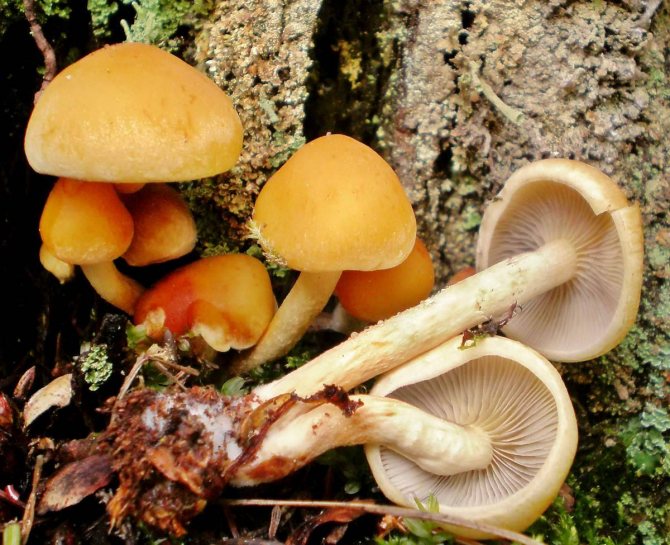
The flesh of the cap is pale yellow, sometimes white, thin, not bitter, practically odorless, but old specimens have a pungent smell of dampness. Spores are bluish-gray in color.
Places of growth of seroplate
These mushrooms are found mostly in the temperate climates of the Northern Hemisphere.Most often they can be found in coniferous mountain forests, and in deciduous forests they are extremely rare.
Gray lamellar pseudoholes grow mainly on coniferous stumps, on roots and on decaying trees. You can meet these mushrooms from June to November, but the peak of mass ripening is observed from September to October. Gray-lamellar pseudo-weavers settle in large colonies, they grow alone very rarely.
Some types of fungi form mycorrhiza - a kind of symbiosis with plants.
lamellar false pigs are symbiotes. Their myceliums envelop the roots of trees and penetrate inside, so the mushrooms feed. For the plants themselves, such an alliance is also useful, since with the help of mushroom roots they receive minerals from the soil. Pines grow strong and tall when they form beneficial alliances with mushrooms. And when false heaps settle on sick trees, they destroy them. That is, in fact, seroplamellar pseudo-weavers are orderlies. Because they destroy old trees in the forest.
Reproduction of gray-lamellar false hoofs
As with all fungi, reproduction in the seroplamellar pseudo-foil occurs with the help of spores. The shape of the spores is elongated, the surface is smooth, the color of the spore powder, like in many stropharia, is bluish-gray or dark purple.
The spores are attached to the plates. The number of disputes is enormous. They are carried by the wind in different directions. When the spores land on the ground, myceliums begin to form.
Edibility of seroplate pseudo-foam
Pseudo-lamellar is a pseudo-edible mushroom. In general, representatives of the stropharia family are classified as poisonous mushrooms, but certain species, nevertheless, can be eaten after proper processing.
The gray-lamellar pseudo-foam belongs to the 4th category in terms of taste. This mushroom is suitable for preparing a variety of dishes, but it is not added fresh to food, but boiled for 15 minutes. In addition, gray-lamellar false weavers can be salted, pickled and dried. The smell and taste of this mushroom are soft and pleasant.
It is recommended to eat young gray-lamellar false pigs, as older specimens develop an unpleasant odor. It is advisable to collect only hats, since the legs, like those of other mushrooms, are too hard.
In Western Europe, gray-lamellar pseudo-foil is a popular mushroom; mushroom pickers collect it with great pleasure.
Similar species
The gray-lamellar pseudo-foam can be mistakenly confused with other fungi of the genus Gifoloma:
- The brick-red pseudo-foam got its name from its characteristic color. This mushroom is not poisonous, but it is not eaten. Its distinctive feature is the yellowish plate. The flesh is quite dense, and the taste is bitter;
- The sulfur-yellow false foil is a poisonous member of the family; it can be distinguished by green plates and sulfur-yellow pulp and cap;
- Galerina bordered, similar to the seroplate pseudo-foil, in general, is very dangerous, as it is deadly poisonous. It is distinguished by brown plates and rusty spore powder.
- Summer honey fungus differs from gray lamellar false foam in light pulp. His plates range from fawn to gray at different ages. There is no unpleasant smell or bitterness.
.
Omphalotus oleifera (Omphalotus olearius)
Synonyms:
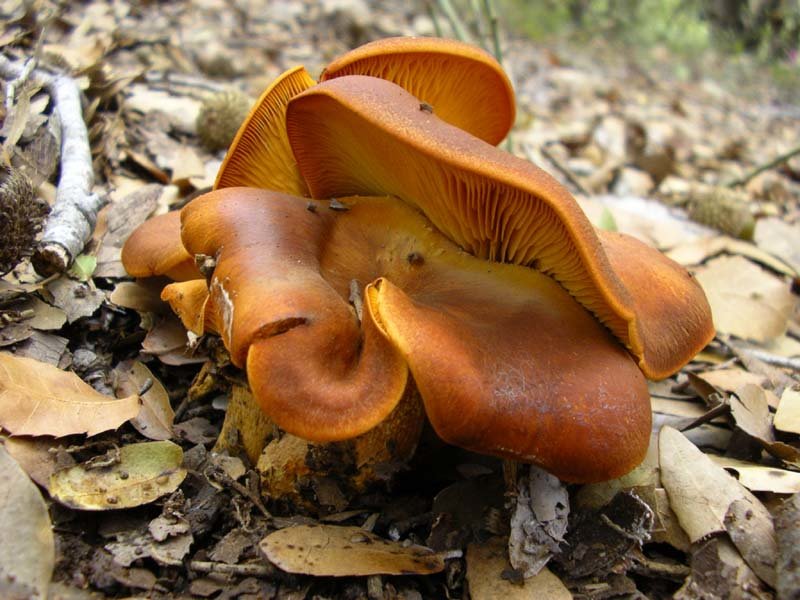
Omphalot olive is a species of lamellar mushrooms from the Marasmiaceae family.
Olive omphalot hat:
the cap of the mushroom is rather dense and fleshy. In a young mushroom, the cap has a convex shape, then it becomes prostrate. In a fully ripe mushroom, the cap is depressed in the central part, even slightly funnel-shaped with strongly curved edges. There is a noticeable tubercle in the center. The skin of the cap is shiny, smooth, with radial thin veins. The diameter of the cap is from 8 to 14 centimeters. The surface is colored orange-yellow, reddish-yellow or yellowish-brown. Ripe mushrooms, in dry weather, turn brown with wavy, cracking edges.
Leg:
high, strong stem of the mushroom is covered with longitudinal grooves. At the base, the leg is pointed. In relation to the cap, the leg is slightly eccentric. Sometimes located in the center of the cap. The leg is dense, of the same color as the cap or slightly lighter.
Plates:
frequent, interspersed with a large number of short plates, wide, often branched, descending along the pedicle. It happens that a light glow emanates from the plates at night. The plates are yellowish or orange-yellow.
Olive omphalot pulp:
fibrous, firm flesh, yellowish. At the base, the flesh is slightly darker. It has an unpleasant odor and practically no taste.
Disputes:
smooth, transparent, spherical. Spore powder, also has no color.
Variability:
The color of the cap can vary from yellow-orange to reddish brown dark in color. The hat is often covered with dark spots of various shapes. Mushrooms growing in olives are colored completely reddish-brown. The leg is the same color as the cap. The plates are golden, yellow with a light or intense shade of orange. The pulp may have light or dark spots.
Spreading:
Omphalotus oleifera grows in colonies on stumps of olives and other deciduous trees. Occurs on low mountains and plains. Fruiting from summer to late autumn. In olive and oak groves, bears fruit from October to February.
Edibility:
the mushroom is poisonous, but not fatal. Its use leads to severe gastrointestinal upset. Symptoms of poisoning appear about a couple of hours after eating the mushrooms. The main signs of poisoning are nausea, headache, dizziness, convulsions, colic, diarrhea and vomiting.
Interesting information about poplar mushrooms
Poplar honey fungus (Cyclocybe aegerita) contains a special component called methionine. It is an essential amino acid for the human body that has a great impact on the correctness of metabolism and growth. Agrocybe is widely used in folk and official medicine, being an excellent remedy for chronic headaches and hypertension. Poplar honey is also known as one of the best natural producers of antibiotics. On the basis of this mushroom, a medicinal preparation of complex action called agrocybin is made. It is actively used to fight against a large group of parasites, fungi and bacteria. The component lectin was also isolated from poplar honey, known for its antitumor effect, and is a powerful prophylactic agent against the development of cancer cells in the body.
Humpbacked row (Tricholoma umbonatum)
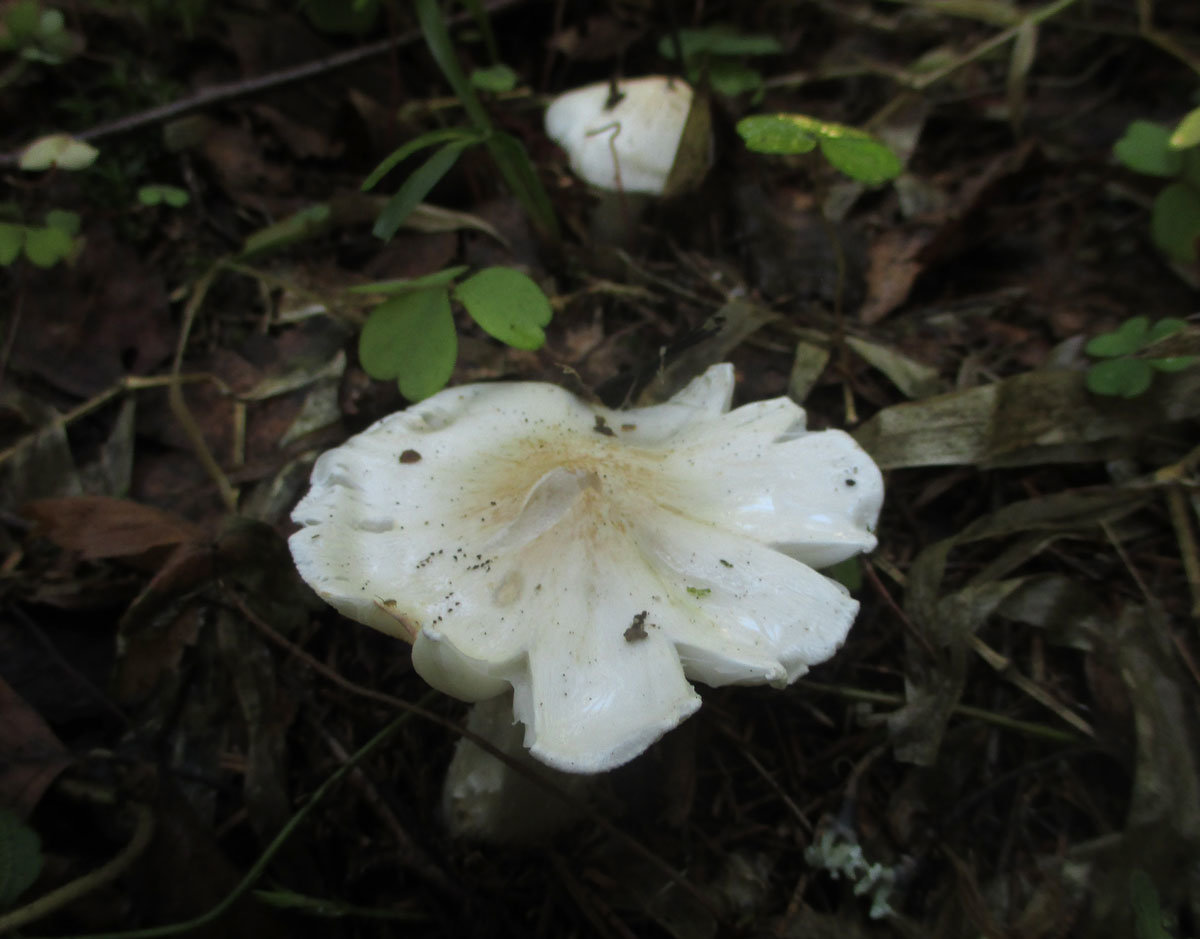
Etymology
Specific epithet Tricholoma umbonatum Clémençon & Bon, in Bon, Docums Mycol. 14 (no. 56): 22 (1985) derives from lat. umbo - which means "hump" in translation. And, indeed, the "humpback" of the cap is characteristic of this species.
Description of the mushroom
A hat with a diameter of 3.5-9 cm (up to 115), in youth conical or bell-shaped, at the age from conical to open, often with a hump with a more or less pronounced sharpening, smooth, sticky in wet weather, shiny in dry weather, more or less pronounced radial fibrous. In dry weather, the cap often breaks radially. The color of the cap is whitish towards the edges, noticeably darker in the center, olive-ocher, olive-brown, greenish-yellowish, greenish-brown. The radial fibers are of low contrast.
The pulp is whitish. Smell from mild to starchy, may have unpleasant undertones. The smell of the cut is noticeably floury. Flour taste, maybe a little nasty.
The plates are notched-accrete, rather wide, frequent or medium-frequent, white, often with an uneven edge.

White spore powder, hyaline spores in water and KOH, smooth, mostly ellipsoidal, 4.7-8.6 x 3.7-6.4 μm, Q 1.1-1.6, Qe 1.28-1.38
The leg is 5-10 cm long (up to 15), 8-20 mm in diameter (up to 25), white, yellowish, cylindrical or tapering to the bottom, often deeply rooted, may have a pinkish-brownish color at the base. Usually pronounced longitudinally fibrous.

Habitat
The humpbacked row grows from the end of August to November, is associated with oak or beech, prefers clay, and according to some sources, calcareous soils. The fungus is quite rare.
Similar species
- Row white (Tricholoma album), Row foul-smelling (Tricholoma lascivum), Row with lamellar (Tricholoma stiparophyllum), Rows of Tricholoma sulphurescens, Tricholoma boreosulphurescens, Row of stinking (Tricholoma inamoenum) with a pronounced fibrous surface and a pronounced odorless shade They do not have characteristic humps on the cap. Of these species, only T. album, T. lascivum and T. sulfurescens can be found nearby, as associated with oak and beech, the rest grow with other trees.
- The row is whitish (Tricholoma albidum). This species has a not very clear status, it seems, for today, it is a subspecies of the silver-gray row - Trichioloma argyraceum var. albidum. It is distinguished by the absence of greenish and olive tones in the cap, and yellowing in places of touch and damage.
- Pigeon row (Tricholoma columbetta). Differs in the absence of olive and greenish tones in the cap, does not have a "hump", does not have a noticeable darkening in the center of the cap. Phylogenetically, it is the closest species to this row.
- The row is different (Tricholoma sejunctum). This view is easily confused with the data. It is distinguished by the absence of such a pronounced hump on the cap, and by a non-rooting leg. However, in my opinion, mushrooms are not at all similar in color and contrast of colored fibers on the cap. Could T.sejunctum be so light, or T.umbonatum so brightly colored?
Edibility
The edibility is unknown, as the mushroom is quite rare.
Used literature 1. Christensen, Morten & Heilmann-Clausen, Jacob. (2013). The genus Tricholoma. 2. Henning Knudsen (Editor), Jan Vesterholt “Funga Nordica (2-Volume Set): Agaricoid, Boletoid, Clavarioid, Cyphelloid and Gastroid Genera”, 2012.
What does a mossy mossy foam look like?
Fruiting bodies are small in size with a small cap, the diameter of which does not exceed 3.5-4 cm. The size is disproportionate to the length of the leg, which can reach up to 12 cm.
Mushrooms grow in small groups or singly
Description of the hat
The upper part of the mossy pseudo-foam at the beginning of growth is rounded dome-shaped, over time it becomes prostrate hemispherical, in mature fruiting bodies - flat.
- the color of the protective film is not monotonous, the central part is dark with well-defined borders;
- surface with fine wrinkles and thin vertical stripes, slimy, especially at high humidity;
- the edges are uneven, slightly wavy with scaly remnants of the bedspread;
- the lower spore-bearing layer is lamellar, the plates are wide, arranged non-compactly with uneven edges;
- hymenophore with a clear border below, does not extend beyond the cap;
- the color is light brown or dark beige with a gray tint.
The pulp is creamy, thin, the structure is brittle.
On the edge are short and medium length plates
Leg description
The central leg is narrow and long, even, sometimes slightly curved towards the apex. The thickness is the same everywhere - an average of 4-4.5 mm. The structure is fine-fiber, the inner part is hollow. Painted in one color. On the surface near the ground, young mushrooms have a fine-flaked coating, which completely crumbles by maturity.
On cut, the leg splits into several parts along the length of the fibers
False honey fungus (poppy)

However, it is worth noting that even when collecting honey agarics, you need to be careful. In our forests, in addition to edible species: summer, autumn and winter, there are also varieties of false honey agarics. Some of them can be eaten, as they are called conditionally edible, while others are poisonous. Therefore, in order to understand, you need to have some knowledge about the appearance of edible and inedible mushrooms. You should also know where they meet and at what time they grow.
An edible mushroom is considered to be a gray-lamellar honey fungus, which confidently differs from poisonous mushrooms. That is why lovers of "quiet hunting", in addition to knowledge about mushrooms, must have color-sensitive eyesight.We suggest that you familiarize yourself with the description and photo of the seroplate mushroom:


Seroplate honey fungus (hypholoma capnoides): photo and description
Latin name: Hypholoma capnoides
Genus: Gifoloma.
Family: Stropharia.
Synonyms: poppy honeydew, poppy honeydew, seroplate honeycomb, poppy hypholoma.
Hat: 3 to 7 cm in diameter, hemispherical in juveniles and convex-open in mature specimens. Often, pieces of the coverlet remain at the edges of the cap. The hat is hygrophilous, that is, the color depends entirely on the humidity of the air. In dry weather, the cap is dull yellow, richer in color in the middle. In humid weather, it turns light brown with a bright middle. The flesh at the cap is whitish and thin, has a faint smell of dampness.
Stem: gray-lamellar honeydew has a stem with a height of 4 to 8 cm. Its thickness ranges from 0.3 to 0.9 cm. The upper part is yellowish, and the lower one is reddish-brown. The shape resembles a cylinder, often curved and with scraps of "skirt".
Plates: gray-lamellar honeydew has dense and adherent plates. In young mushrooms, the plates are yellowish with a white tint; when they grow up, they become the color of a poppy seed.
Distribution: only grows on stumps, dying trees and roots hidden in the soil. It is a frequent visitor to conifers, especially spruces and pines. Grows easily in lowlands and high in the mountains. The entire temperate zone of the northern hemisphere abounds in this type of mushroom. Honey mushrooms are collected from April to October, and sometimes, if the winters are warm, then in December.
Edibility: Hypholoma capnoides is an edible fungus, similar to summer honey fungus. Only overripe specimens have a musty odor of dampness. Young individuals smell pleasant, their smell resembles a forest aroma, combined with the smell of earth.
When to collect seroplate mushrooms and what to cook from them
Experienced mushroom pickers call the seroplate honeydew "the second summer honeydew", it belongs to the 4th category. A wide variety of dishes can be prepared from it, they can be salted, dried, pickled. Before use, the honeydew honey should be boiled in salted water for 15-20 minutes. In addition, experts recommend collecting only the caps from this fruiting body, since their legs are very hard, similar to rubber. Look at the photo of the gray-lamellar honey fungus, which is often found in the forests of all Russian regions:


Mushroom pickers are used to collecting only 3 types of edible mushrooms: summer, autumn and winter. However, there is such a mushroom, which is called a false honey fungus. It is an edible mushroom, although many people bypass it. Its main problem is that it looks like poisonous and inedible mushrooms.
All mushrooms, including seroplate, can be harvested from spring to late autumn. They grow mainly on stumps, dying trees, wind-blown trunks and fallen branches. Sometimes they can be found right on the ground. However, this does not mean that they grow there directly on the soil. Apparently, under the surface of the earth there are roots from some stump or tree.
If you decide to collect gray-lamellar false honey, be careful - this mushroom is very easy to confuse with sulfur-yellow false foam, which is considered dangerous. However, poisonous mushrooms have green plates and taste very bitter.
The most important factor in picking mushrooms is always a single rule: pick those mushrooms that you are sure of. If you do not have color photographs of all edible mushrooms with you, go to the forest with a knowledgeable person with experience in this matter.
Definitioner
Lat. Basidia. A specialized structure of sexual reproduction in fungi, inherent only in Basidiomycetes. Basidia are terminal (end) elements of hyphae of various shapes and sizes, on which spores develop exogenously (outside).
Basidia are diverse in structure and method of attachment to hyphae.
According to the position relative to the axis of the hypha, to which they are attached, three types of basidia are distinguished:
Apical basidia are formed from the terminal cell of the hypha and are located parallel to its axis.
Pleurobasidia are formed from lateral processes and are located perpendicular to the axis of the hypha, which continues to grow and can form new processes with basidia.
Subasidia are formed from a lateral process, turned perpendicular to the axis of the hypha, which, after the formation of one basidium, stops its growth.
Based on morphology:
Holobasidia - unicellular basidia, not divided by septa (see Fig. A, D.).
Phragmobasidia are divided by transverse or vertical septa, usually into four cells (see Fig. B, C).
By type of development:
Heterobasidia consists of two parts - hypobasidia and epibasidia developing from it, with or without partitions (see Fig. C, B) (see Fig. D).
Homobasidia is not divided into hypo- and epibasidia and in all cases is considered holobasidia (Fig. A).
Basidia is the place of karyogamy, meiosis and the formation of basidiospores. Homobasidia, as a rule, is not functionally divided, and meiosis follows karyogamy in it. However, basidia can be divided into probasidia - the site of karyogamy and metabasidia - the site of meiosis. Probasidium is often a dormant spore, for example in rust fungi. In such cases, probazidia grows with metabasidia, in which meiosis occurs and on which basidiospores are formed (see Fig. E).

